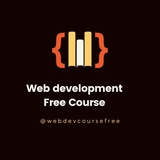tg-me.com/webdevcoursefree/1990
Last Update:
React.js 30 Days Roadmap & Free Learning Resource 📍👇
👨🏻💻Days 1-7: Introduction and Fundamentals
📍Day 1: Introduction to React.js
What is React.js?
Setting up a development environment
Creating a basic React app
📍Day 2: JSX and Components
Understanding JSX
Creating functional components
Using props to pass data
📍Day 3: State and Lifecycle
Component state
Lifecycle methods (componentDidMount, componentDidUpdate, etc.)
Updating and rendering based on state changes
📍Day 4: Handling Events
Adding event handlers
Updating state with events
Conditional rendering
📍Day 5: Lists and Keys
Rendering lists of components
Adding unique keys to components
Handling list updates efficiently
📍Day 6: Forms and Controlled Components
Creating forms in React
Handling form input and validation
Controlled components
📍Day 7: Conditional Rendering
Conditional rendering with if statements
Using the && operator and ternary operator
Conditional rendering with logical AND (&&) and logical OR (||)
👨🏻💻Days 8-14: Advanced React Concepts
📍Day 8: Styling in React
Inline styles in React
Using CSS classes and libraries
CSS-in-JS solutions
📍Day 9: React Router
Setting up React Router
Navigating between routes
Passing data through routes
📍Day 10: Context API and State Management
Introduction to the Context API
Creating and consuming context
Global state management with context
📍Day 11: Redux for State Management
What is Redux?
Actions, reducers, and the store
Integrating Redux into a React application
📍Day 12: React Hooks (useState, useEffect, etc.)
Introduction to React Hooks
useState, useEffect, and other commonly used hooks
Refactoring class components to functional components with hooks
📍Day 13: Error Handling and Debugging
Error boundaries
Debugging React applications
Error handling best practices
📍Day 14: Building and Optimizing for Production
Production builds and optimizations
Code splitting
Performance best practices
👨🏻💻Days 15-21: Working with External Data and APIs
📍Day 15: Fetching Data from an API
Making API requests in React
Handling API responses
Async/await in React
📍Day 16: Forms and Form Libraries
Working with form libraries like Formik or React Hook Form
Form validation and error handling
📍Day 17: Authentication and User Sessions
Implementing user authentication
Handling user sessions and tokens
Securing routes
📍Day 18: State Management with Redux Toolkit
Introduction to Redux Toolkit
Creating slices
Simplified Redux configuration
📍Day 19: Routing in Depth
Nested routing with React Router
Route guards and authentication
Advanced route configuration
📍Day 20: Performance Optimization
Memoization and useMemo
React.memo for optimizing components
Virtualization and large lists
📍Day 21: Real-time Data with WebSockets
WebSockets for real-time communication
Implementing chat or notifications
👨🏻💻Days 22-30: Building and Deployment
📍Day 22: Building a Full-Stack App
Integrating React with a backend (e.g., Node.js, Express, or a serverless platform)
Implementing RESTful or GraphQL APIs
📍Day 23: Testing in React
Testing React components using tools like Jest and React Testing Library
Writing unit tests and integration tests
📍Day 24: Deployment and Hosting
Preparing your React app for production
Deploying to platforms like Netlify, Vercel, or AWS
📍Day 25-30: Final Project
*_Plan, design, and build a complete React project of your choice, incorporating various concepts and tools you've learned during the previous days.
Web Development Best Resources: https://topmate.io/coding/930165
ENJOY LEARNING 👍👍
BY Web Development
Warning: Undefined variable $i in /var/www/tg-me/post.php on line 283
Share with your friend now:
tg-me.com/webdevcoursefree/1990
